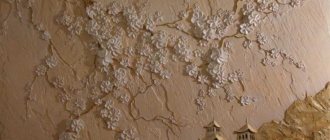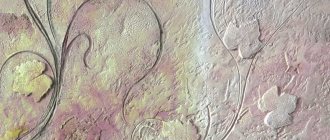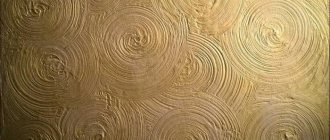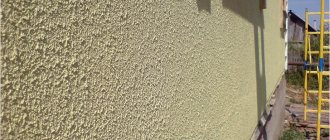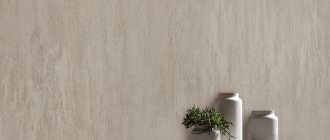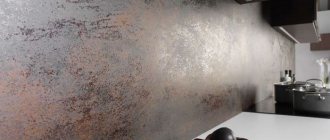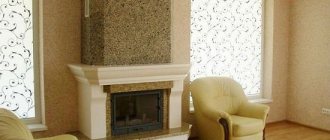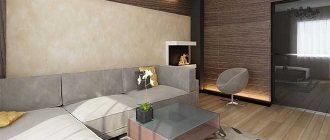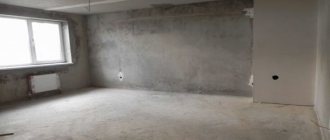Features of textured plaster
The composition of textured plaster, along with the binder, also includes other components that make its consistency softer - pieces of granite or other minerals.
Using this fine-grained mixture, it is easy to create a colorful texture on the smooth surface of the ceiling and walls. If necessary, it can be used as putty.
Plasters of this type are used for decoration. A thin layer of the composition is applied to the surface of the walls and the desired pattern or relief pattern is created on it.
Their main properties:
- plastic;
- viscosity;
- strength;
- no shrinkage after applying the layer and drying it;
- immunity to high temperatures;
- ease of application on any surface, even with imperfections.
You can make textured plaster yourself. To do this, add stone chips or wood fibers to the usual composition and tint the resulting mass.
This finishing material has a number of advantages over others:
- Textured plasters can be considered a universal way to decorate walls. The original coating can be selected for any interior style.
- Patterns and designs to create texture are done quickly and effortlessly. It is enough to move the roller one or several times.
- The composition includes components that are resistant to ultraviolet rays. The initial color saturation does not change over time.
- You can add different paints to ready-made mixtures and change their shades and tone.
- Characteristic enhancement of the thermal insulation properties of the base.
- Environmentally friendly composition. It does not release harmful substances into the surrounding space. Suitable not only for decorating the exteriors of buildings, but also interiors.
- To increase the aesthetic expressiveness of textured plaster, mother-of-pearl is added to it.
Textured or relief plaster does not smell. It also does not absorb foreign odors. When working with this material, you should strictly follow the rules for applying plasters of any kind to walls. Otherwise, it may begin to gradually collapse. Or vice versa, it will be very difficult to remove it, if necessary.
The use of textured and structural rollers
A simple way to make textured plaster from ordinary putty with your own hands is to use a special roller. It is quite simple to obtain the desired quality of finish in this way.
Depending on the working surface of this tool, the desired result is obtained - the desired pattern on the wall.
Rollers differ in the material they are made of:
- Pile rollers . The pile can be either long or short, and the fur can be either artificial or natural. The length of the pile should be selected based on what kind of relief you need, convex or smoothed. You need to pay attention to the quality of the fur: if you slightly pull its pile, it should not be pulled out. If this happens, then under no circumstances should you purchase such a roller! Not only will your work turn into torture, you will also ruin the putty and waste your time: a shedding roller is unsuitable for such work, since the pile will constantly stick to the surface being treated.
- Rubber rollers . When working with them, it is necessary to control the degree of pressure of the tool on the wall. The designs on them imitate various patterns, ornaments and masonry.
- Wooden rollers . The pattern left by this tool is very similar to the imprint of a rubber roller. But it is the wooden surface that makes the work of the finisher or home craftsman easier - the solution does not stick to the roller. Among the disadvantages: the material on it dries out a lot, and the instrument always needs careful washing and cleaning.
- Leather rollers . They are used when working with Venetian plaster, thus creating an imitation of a marble surface or other structure. In order for this roller to serve you for a long time, you should buy a product made of genuine leather. But if this tool is purchased for one repair, there is no point in spending money on leather.
- Plastic rollers . A cheaper tool that high-level craftsmen do not use. The plastic will crack, and as a result, flaws will remain on the surface being treated.
In addition to the listed rollers, there are also tools made of foam rubber, fabric, polyethylene, with a spirally attached cord. With their help you can achieve a rough surface with a pattern.
Important! You should not press too hard on the tool while working - a clear pattern is obtained only with minimal force. The tool must be moved from top to bottom without stopping, pressing firmly against the finished strip.
These tools fall into two categories:
- Textured roller . They are different. You can choose a fleecy roller and work with it, or a roller with patterns. Such rollers are designed to imitate the texture of various materials: stone, marble, wood, etc. The pattern can be either concave or convex - this is achieved thanks to the pattern on the roller.
- Structural roller . Serves to obtain a uniform pattern of varying complexity. In this case, no other tools are used. A closed pattern is applied in the form of grooves, lines, protrusions. The applied composition is leveled using a spatula with this roller. After the mixture has partially dried, the surface can be corrected with a brush to smooth out sharp corners, as a result of which the pattern will turn out soft.
Types of textured plasters
There are several types of popular plasters. They are easy to make yourself. This does not require any special professional skills. A solid but breathable compound applied to a flat surface can resemble wood, leather, natural stone or fabric.
Bark beetle
The plaster called “Bark Beetle” resembles a wooden surface eaten away by bugs. The color, size and volume of the fractions differ.
The walls of a building or room can be decorated either completely or fragmentarily. “Bark beetle” is a finishing coating that is applied to stone, brick, cement, plasterboard or wood surfaces that are strong enough to support the weight of the plaster without deformation. Bright and expressive effects can be achieved using mixtures with inclusions of different sizes.
In this case, their properties will be identical. This type of plaster is also successfully used for exterior work - finishing fences, walls, garden gazebos.
They decorate bathrooms and swimming pools. To prevent exposure to moisture, the finished surface is coated with a special protective varnish.
Under the brick
One of the most stylish and interesting types of textured plaster is considered to be an imitation of a brick wall. Smooth, unsloping walls are suitable for decoration. If there are flaws or tilt, the defects are first eliminated. The cracks or individual recesses are sealed with mortar. The cemented surface is primed. If the walls are smooth, there is no need to use cement mortar. They are immediately treated with a primer with the addition of glue. When creating a brick finish, you should take into account the dimensions of real bricks, which are not only rectangular, but also square.
Advantages of homemade plaster
Carrying out repair work often takes a significant toll on the owner’s wallet. After all, you need to purchase a lot of building materials, and if you turn to professionals, you will need to pay a lot of money for the services.
For this reason, many want to find an option that will help them save money, but at the same time get high-quality interior design that stands out for its attractive appearance. Among such methods we can highlight the production of decorative plaster from ordinary putty. In addition to saving money, one should also mention the joy of knowing that you created a beautiful finish with your own hands.
You can highlight the production of decorative plaster from ordinary putty.
Color range of textured plasters
To create plaster mixtures, natural and natural paints are most often used. It is best to imitate wood using yellow or ocher shades, such as straw, golden oak, or pear. But brown colors are also suitable - nut, light brown with a hint of ocher, coffee, cream.
White textured plaster is most often used to decorate public buildings and offices. Its neutral shades allow you to add solemnity to any room with a large area.
This finish is also suitable for small rooms and bedrooms. Makes them lighter, creates the illusion of exceptional purity and freshness. White walls fit perfectly into many interiors and suit any color palette. They prevail in Scandinavian style and in most modern ones.
Gray plaster with a concrete or metal effect is chosen by lovers of high-tech, industrial, techno, minimalism or loft styles.
Mother-of-pearl options with a beautiful patterned texture will delight owners of interiors in oriental styles - Arabic, Indian, Moroccan and Asian. The walls look especially original in combination with mirrors and decor with mother-of-pearl inclusions and silver metal.
Compound
Usually, mica, gypsum, sand, ground brick particles, and wood fibers are added as inclusions to plaster mixtures.
Textured acrylic plasters also contain acrylic resins. This allows you to give the mixture the necessary plasticity and increases the possibility of setting with bases of all types.
The use of a spectrum of acrylic paints makes acrylic-based plasters the leaders. This finish is durable and durable. But there are also disadvantages. First of all, the flammability of the mixture and the ability to attract dust.
Acrylic
It is based on acrylic resin, and the material itself can be applied to a wide variety of surface types. As a rule, it is sold in ready-made form. It is characterized by elasticity and durability. Having a low level of moisture absorption, this mixture is resistant to moisture, as well as to changes in the base. At the same time, there are disadvantages:
- rapid flammability;
- possibility of loss of appearance.
How to apply textured plaster
Home comfort and cleanliness often depend on the right choice of materials. Decorative plaster is considered one of the most interesting design options for modern apartments and building facades. It can be applied to walls and ceilings either by hand or using mechanisms, for example, a plastering station. A large selection of textures and shades allows you to use the compositions in new design projects or complement the design of walls and ceilings in previously created interiors.
Before starting work on applying textured plaster to any surface, you need to clean it of any remaining wallpaper, debris or dust. And then do the following:
- Carefully prime the wall.
- Choose a relief based on the capabilities and characteristics of the room. It can be a rock, wood, natural stone, orange peel, bark beetle and a number of others.
- Evenly distribute the contents of the package or container over the surface using a spatula.
- Adjust the resulting patterns or texture with a brush or sponge, and smooth out the resulting seams.
- To give the texture greater relief, you can use not only construction tools, but also improvised means: flat paint brushes, a notched trowel, a relief roller, crumpled stiff paper or whatman paper.
Improvements to conventional tools
If desired, you can improve the roller. For example, it is wrapped in honey. a rope, it can be a clothesline or an ordinary rope with knots, or the roller is wrapped in some kind of fabric. Thus, it is possible to obtain unusual results.
How to do decorative plaster with your own hands using various devices, the video will help you figure it out. By looking at how those who have already studied this issue work, you can quickly understand what’s what and decide on the required option.
Note!
Do-it-yourself heating in a private house: how to heat a house, cottage and apartment. Fundamentals, norms and legal supportDo-it-yourself siding installation: step-by-step instructions on how to install external PVC trim
DIY floor screed | Experts show and explain how to make a screed correctly
To understand the features of how decorative plaster is applied with your own hands, the video will allow you to create unusual textures from inexpensive components.
Application in the interior
Decorative wall decoration in the form of textured plaster allows you to emphasize the advantages of various interiors. The presence of Bark Beetle plaster in an apartment or office enhances its modern look and adds practicality to the design.
The matte surface with long grooves applied to it is very similar to wood. Beige, blue or pink shades are chosen for bedrooms, and more saturated colors for hallways.
Kitchen walls coated with a dark composition will look gloomy. Therefore, they plaster with textured mixtures with delicate shades or combine colors.
Textures similar to drops of water, sea foam or snake skin look impressive.
Imitation from putty
It is not necessary to prepare a special mixture if you need a textured surface. It can also be imitated from ordinary materials.
You will need:
Ready-made acrylic putty, colorless water-dispersion acrylic varnish, glue for non-woven wallpaper, color.
Preparation and application:
Apply a 2 mm layer of putty with a spatula and give it a texture with a trowel before it dries. After 15 minutes, lightly smooth the surface, and after 10 hours, walk over it with fine-grained sandpaper. Mix glue for non-woven wallpaper with color and apply it to the wall moistened with a sponge with a spatula and trowel, and after drying, cover with varnish.
Hallway design 2021: fresh ideas and trends (photos)
How to make textured plaster yourself
The cost of the decorative composition depends on the brand of the incoming components. Buying ready-made textured plaster from well-known manufacturing companies can be expensive. But, if you make the mixture with your own hands from putty, then decorating the walls with it will be much more profitable than with wallpaper. The mixture, made independently, is suitable for application with a roller or using a stencil:
- The base is gypsum or chalk powder (6 kg 500 g).
- 2 kg of CMC glue solution (5%). Bred in accordance with the recommendations src=”https://balkon4life.ru/wp-content/uploads/2020/04/5e284af49f35998f484a3455.jpg” class=”aligncenter” width=”480″ height=”600″[/img]
- 800 g PVA glue.
- 1 bar of laundry soap (72%) serves as a plasticizer. Grind on a grater and dilute with water to the consistency of thick sour cream or gel.
It is better to mix the ingredients with a construction mixer. First, liquid components, and then gradually add powdered ones. Leave for a while and then mix more intensively. This composition has a long drying period, which allows it to be used even by inexperienced beginners.
Photo of decorative plaster
| European-quality renovation from A to Z If you know how to hold a hammer, spatula, screwdriver in your hands, then you have every chance to earn from 80,000 rubles/month in the conditions of the global crisis! Read more >> |
Price
The cost of the decorative composition depends on the brand of the incoming components. Buying ready-made textured plaster from well-known manufacturers can be expensive. The price for 1 m2 of treated surface depends on the professionalism of the specialist, the quality and speed of work. If you do everything yourself, then renovations in a house or apartment can be done without spending a lot of money and time.
But you can also buy a ready-made mixture. VGT textured plaster is easy to apply. It is highly viscous and coarsely dispersed. It is distinguished by its versatility, as it can be used to decorate various coatings. In addition to elasticity, the composition is moisture resistant. Suitable for indoor and outdoor use. Preliminary preparation of surfaces is not necessary. All defects are smoothed out using this mixture, which is made on the basis of acrylic binders and marble chips. One container holds 18 kg. 2 kg of mixture is required per 1 m2 (when applied in one layer). This means that one container is enough to treat a wall with an area of 9 m2.
Subscribe
What can be used to create a decorative effect
You can make different drawings on the surface using completely different means. For this purpose, methods with special application of the composition are in the first row. Work with a notched trowel or trowel can be used; they move randomly, or equally in one chosen direction.
Ready-made textured rollers, stencils, which can even be simply cut out of cardboard of different density. From available items you can use paper that is crumpled, plastic bags, a sponge, and unusual objects.
You can make different drawings on the surface using completely different means.
Coloring compounds
If plaster, pre-painted in the desired shade, is applied, it is advisable to protect the surface with a varnish. When finishing facades, it is necessary to carry out painting on a dried base of the plaster layer.
The coloring process consists of the following technology:
- Preliminary priming of the material is carried out.
- For painting, use a roller with long pile, apply one layer of paint, wait until the layer dries completely.
- The application of the 2nd layer should be carried out with a roller with short bristles; it is also necessary that the layer dries well.
- The final layer is applied with a varnish, then the coating will be glossy. If desired, you can also add shiny elements to the varnish base, but then you need to stir frequently so that all the sparkles do not remain at the bottom of the bucket.
If plaster, pre-painted in the desired shade, is applied, it is advisable to protect the surface with a varnish.
Decorative plaster is an option for creating a unique coating on the wall; you can get a variety of patterns on the surface. The master can show his imagination. At the same time, it is possible to significantly reduce repair costs if you prepare the solution yourself; this does not require purchasing a huge amount of ingredients. Also, obtaining the product is not difficult, and the result will look much as beautiful as the finished composition from the manufacturers.

